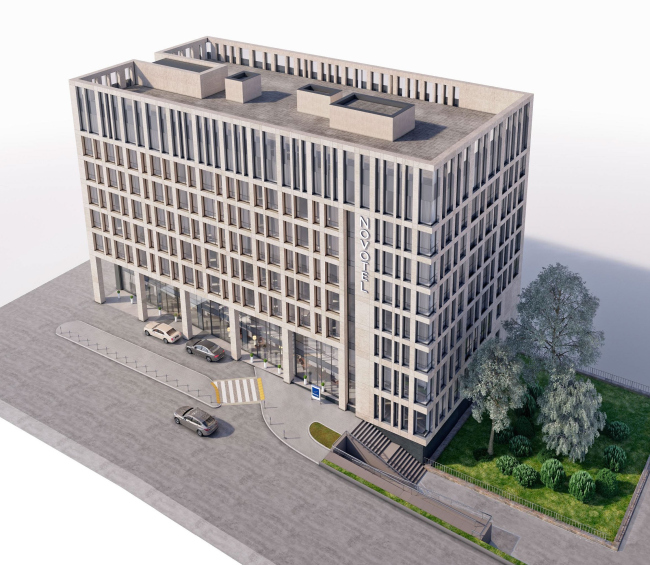|
Published on Archi.ru (https://archi.ru) |
|
| 18.12.2019 | |
|
Next to the Theater |
|
|
Julia Tarabarina |
|
| Architect: | |
| Pavel Andreev | |
| Studio: | |
| GRAN | |
|
On the Zemlyanoi Val Street, left of the entrance to the automotive tunnel underneath the Taganskaya Square, in front of the Taganka Theater, and next to the side end of Chocolate housing complex, the eight-story Novotel building, designed by Pavel Andreev, is being completed. The hotel on the Zemlyanoi Val Street. The layouts of the 2nd and 3rd floorsCopyright: © GRANThe eight-story parallelepiped with three underground tiers has a square plan; its project got all of the necessary approvals of the hotel operator Accor, which manages the Novotel chain. The main floors are grouped around the elongated staircase and elevator hall; the hotel rooms are lined up along the longer facades, the eastern and the western ones, and along the northern side end – this was done to avoid the window-to-window view with one of the Chocolate buildings, which, by a lucky coincidence, are only present in the northern part there. The hotel on the Zemlyanoi Val StreetCopyright: © GRANThe building is filling in the lacuna in the red line of the Zemlyanoi Val, repairing the construction front, and fitting in nicely with the rhythmic alternation of the old Moscow two-story houses and higher buildings, one of which is the Taganka Theater, and another, on the right, is a former tenement, built back in the 1910’s. The hotel on the Zemlyanoi Val Street. A version of the facadeCopyright: © GRANAnd, while the brand book of the hotel operator makes the inner structure of the building rather predictable, the facade-forming, vertically focused, grid of light stone, just as the tripartite division into the basement tier, the middle, and the attic, neatly inscribes the hotel in the context of what you may call “modern latent classic”, rather expensive thanks to glass and stone, yet very appropriate for these historical surroundings. The hotel on the Zemlyanoi Val Street. Versions of the facadeCopyright: © GRANMeanwhile, it still must be noted that the hotel is being built in the high-profile historical center of the city, visible to numerous pedestrians, and the never-sleeping thoroughfare of the Garden Ring, which, on the one hand, required a solution as tactful and delicate as at the same time conspicuous to a certain extent. Thus, in the process of their creative search, the architects considered a lot of options, looking to emphasize in some way both the northeastern corner, clearly visible from a distance and advantageously enhanced by the square of the little park lying in front of it, and the main entrance to the hotel lobby in the left part of the building’s outside facade, closer to the metro station. The hotel on the Zemlyanoi Val Street. Versions of the facadeCopyright: © GRANThe hotel on the Zemlyanoi Val Street. Versions of the facadeCopyright: © GRANThe hotel on the Zemlyanoi Val Street. A version of the facadeCopyright: © GRANThe architects also considered the context of the already existing buildings – the Taganka Theater, a much-acclaimed masterpiece of Art Nouveau architecture designed by Alexander Anisimov, Yuri Gnedovsky, and Boris Tarantsev, the Chocolate housing complex designed by Yuri Grigoryan, and the nearby two-story buildings of the XIX century – and the building that does not exist yet, a shopping mall designed by Aleksey Ginzburg on the opposite side of the Garden Ring. The main version of the project proposed by Pavel Andreev was based on the contrastive combination of two materials – the dark “middle” and the “light” (decorated with glass stripes) L-shaped semi-frame, that marked the main corner. Or the other way around: a light middle and a dark frame. The building was interpreted as consisting of two parts: as if the six-story volume was covered by a large cantilevered structure – this solution can be considered to be one of Pavel Andreev’s favorites, the most vivid examples being the giant “pivot” cantilever in the Vladimirskie Vorota business center (now renamed into Zolotye Vorota), or the “Refrigerator” project on the Dubininskaya Street. However, this form also resonates with the Taganka Theater, where in the place where the large new building and the old small buildings meet, the massive brick band also overhangs above the decorative portico and the fronton. The hotel on the Zemlyanoi Val Street. A version of the facadeCopyright: © GRANThe second theme – accentuating the entrance – is designed in this way: two bottom public floors, the first containing the lobby and a restaurant, the second containing meeting rooms, are joined on the inside by a staircase, and on the outside, visually – by a stained glass window, chamfered in the direction of the theater, yet covered by an array of pylons that marks the red line and forms a thin triangle of the stanza in front of the entrance. Its eaves molding visually continues the top line of the neighboring two-story house, while the sharp corner of the stanza faces the stairway, into which Pavel Andreev turned the slope of the pavement with a three-meter height difference.  The hotel on the Zemlyanoi Val Street. A version of the facadeCopyright: © GRAN The hotel on the Zemlyanoi Val Street. A fragment of the facadeCopyright: © GRAN The hotel on the Zemlyanoi Val Street. The master planCopyright: © GRAN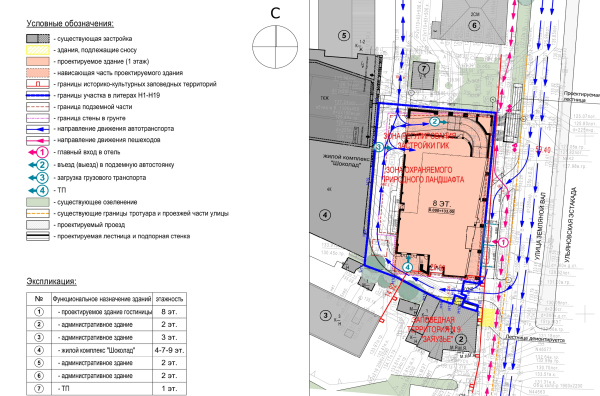 The hotel on the Zemlyanoi Val Street. Location planCopyright: © GRAN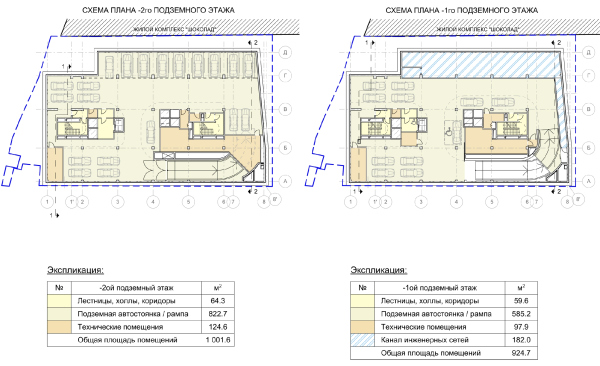 The hotel on the Zemlyanoi Val Street. The layouts of the -1st and -2nd floorsCopyright: © GRAN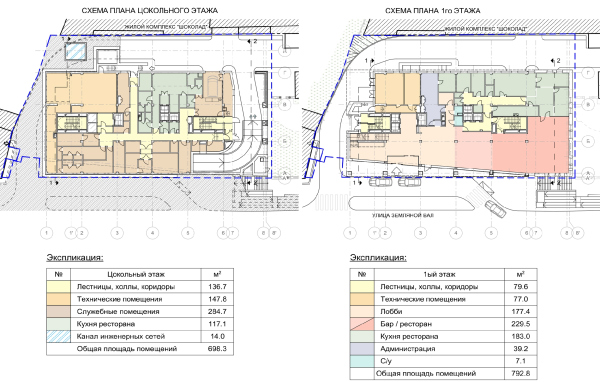 The hotel on the Zemlyanoi Val Street. The layouts of the basement and the first floorsCopyright: © GRAN The hotel on the Zemlyanoi Val Street. The layouts of the standard floors and the 7th floorCopyright: © GRAN The hotel on the Zemlyanoi Val Street. The layouts of the standard floors and the 8th floorCopyright: © GRAN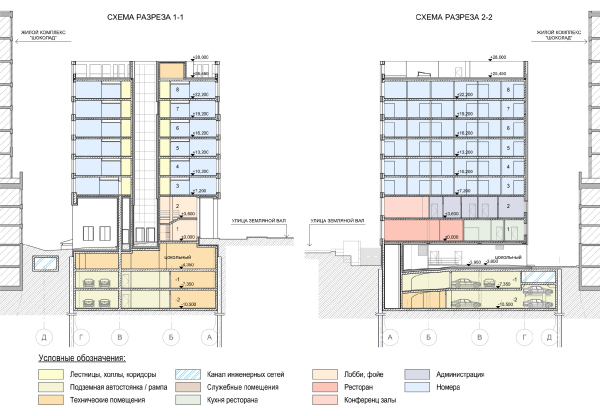 The hotel on the Zemlyanoi Val Street. The section viewsCopyright: © GRAN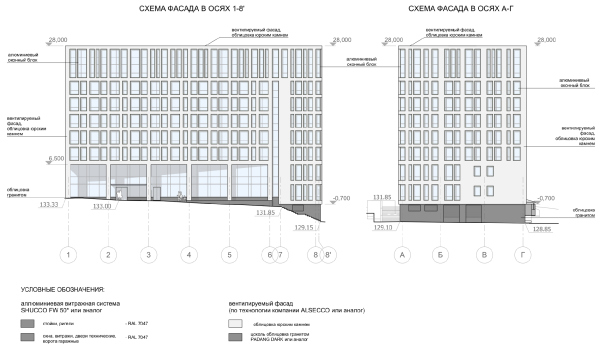 The hotel on the Zemlyanoi Val Street. FacadesCopyright: © GRAN The hotel on the Zemlyanoi Val Street. FacadesCopyright: © GRANIn the author’s final version of the project, the turn of the plane of the bottom floors was also reflected in the bottom part of the façade – turned in quite a hi-tech manner, against the background of the round metallic columns, the bay window created an impression as if the whole volume opens up like a treasure chest with a secret, when pressing one key set the whole mechanism moving. One can plainly see that the turn of the plane not only livened up the building’s plastique and justified the chamfer of the line of the bottom floors, but also resonated with the bristling bay windows of the Taganka Theater- their triangular projections present probably the most recognizable feature of the building designed by Anisimov-Gnedovsky-Tarantsev. 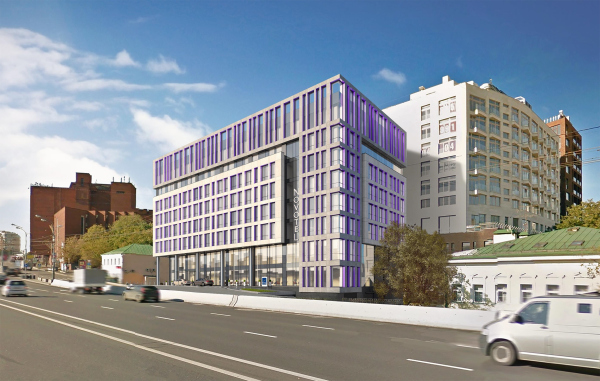 The hotel on the Zemlyanoi Val Street. A version of the facadeCopyright: © GRAN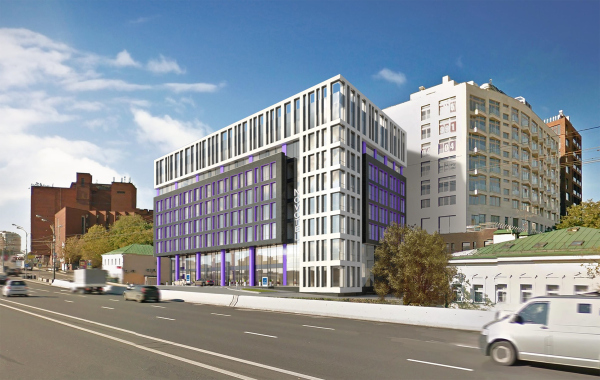 The hotel on the Zemlyanoi Val Street. A version of the facadeCopyright: © GRAN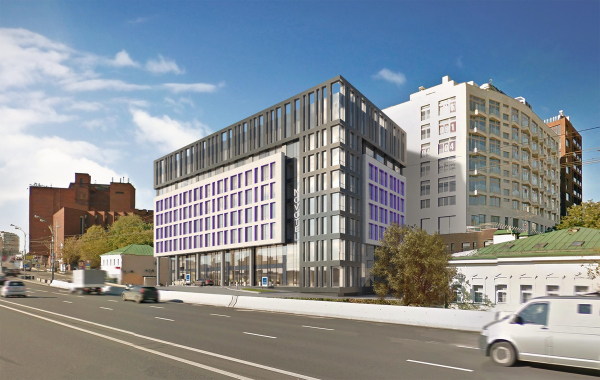 The hotel on the Zemlyanoi Val Street. A version of the facadeCopyright: © GRAN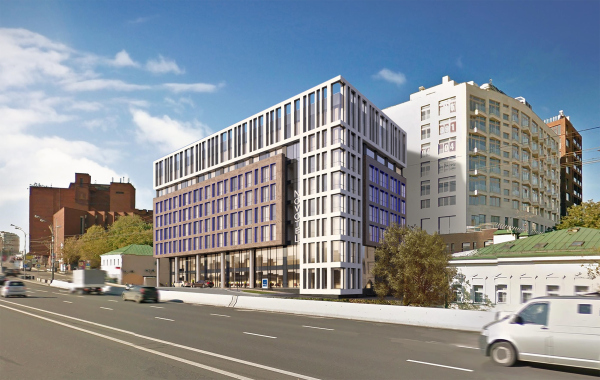 The hotel on the Zemlyanoi Val Street. A version of the facadeCopyright: © GRANHowever, the city’s architectural council advised to “calm the project down”, bringing its contrasting elements to one light tone, at the same time smoothing out the projection, which made the building look much more neutral: what was left of the L-shaped cantilevered structure was only the glass vertical, highlighting the hotel name; what was left of the turn of the planes was the chamfer of the stanza entrance in the first tier. The columns became stone instead of metal, and took on a square section; the hi-tech disappeared into thin air. Now the building holds the red line in much more confident way but it’s unclear whether it’s a good or a bad thing. The project definitely lost some of its expressiveness; it’s hard to say whether the environment won from it. And still the question remains whether the architectural council had a right (well, they probably did have a right to make revisions to the project), but whether these revisions made a positive difference to it, and whether a collective revision as such is a righteous thing to do. Who must ultimately make the decisions? The client? The author? Or the committee? And who, as a consequence, must take responsibility? Will the original idea survive all the committee sittings, and will it keep its integrity? So far, as practice shows, the answer to this question is predominantly circumstantial. |
|






